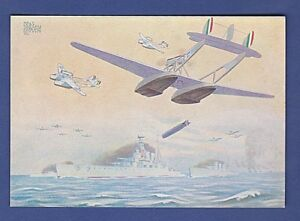The Savoia-Marchetti S.55 twin hulled flying boat was powered by two engines in tandem. The engines were heavily canted in relationship to the hull (the propellers were counter-rotating). Am I correct that the front engine would produce upthrust and the rear engine down thrust? Why was the canted thrust line used? Why weren't the engines made more parallel to the fuselage?
You are using an out of date browser. It may not display this or other websites correctly.
You should upgrade or use an alternative browser.
You should upgrade or use an alternative browser.
Savoia-Marchetti S.55 Engine Question
- Thread starter skyboss
- Start date
- Joined
- 25 June 2014
- Messages
- 1,564
- Reaction score
- 1,483
Both engines would have produced a modest upthrust. They both drove the plane forward, so the rear engine pushed the air down as well as back.
The wings were also rigged with a noticeable angle of incidence, so the plane would have tended to fly somewhat nose-down when lightly loaded and moving fast.
I don't know about the S.55 specifically, but reasons for canting the engines like this include good spray clearance for the exposed front propeller, while keeping the thrust line as close to the centre of drag as possible to minimise engine-out pitch trim changes. Another reason can be to keep the fuselage reasonably level when taking off, so as to avoid the tail digging in to the water.
The wings were also rigged with a noticeable angle of incidence, so the plane would have tended to fly somewhat nose-down when lightly loaded and moving fast.
I don't know about the S.55 specifically, but reasons for canting the engines like this include good spray clearance for the exposed front propeller, while keeping the thrust line as close to the centre of drag as possible to minimise engine-out pitch trim changes. Another reason can be to keep the fuselage reasonably level when taking off, so as to avoid the tail digging in to the water.
archipeppe
ACCESS: Top Secret
- Joined
- 18 October 2007
- Messages
- 2,372
- Reaction score
- 2,765
- Joined
- 25 June 2014
- Messages
- 1,564
- Reaction score
- 1,483
It is always possible that S-M had this in mind, one can seldom prove a negative. But the feature is not seen on any other torpedo bomber that I can think of. On the other hand it is seen on other waterplanes, some of much later date and with quite different roles. So I'd be inclined to credit S-M with similar thinking to theirs.Don't forget that the S-55 was already envisoned as torpedo bomber, so such arrangement would allow a natural dive angle when it launched its torpedo.
P-STICKNEY
ACCESS: Confidential
- Joined
- 28 September 2008
- Messages
- 51
- Reaction score
- 89
Consider this - the engine pair (Tractor in front, and Pusher in back) are mounted well above the airplane's wing/fuselage center of gravity..The Savoia-Marchetti S.55 twin hulled flying boat was powered by two engines in tandem. The engines were heavily canted in relationship to the hull (the propellers were counter-rotating). Am I correct that the front engine would produce upthrust and the rear engine down thrust? Why was the canted thrust line used? Why weren't the engines made more parallel to the fuselage?
The thrust from the propellers will cause the airplane to pitch down when power is increased. To reduce this effect, the engine installation is mounted so that the thrust line of the propellers would produce a nose-up pitch. This solution works best at a single combination of power and airspeed - generally takeoff and climb, where control effectiveness is reduced due to the low airspeed. Think about a go-around on an aborted landing approach - you're changing power quickly, and a strong nose-down pitch will put you nose first into the water.
- Joined
- 25 June 2014
- Messages
- 1,564
- Reaction score
- 1,483
It is quite wrong to imagine that tilting the thrust line up will cause a nose-up pitch with power increase. What matters is how far above or below the CG the line passes (its moment arm). The high-mounted engines mean that a power increase will cause a noticeable pitch-down, something that all seaplane pilots have to get used to (the reverse, loss of power causing a sharp pitch-up, is the more dangerous). Tilting the front engine up on its own would merely reduce this effect, as the thrust line lowers behind it. But tilting the rear pusher raises its line higher in front where the CG is, making things worse.the engine pair (Tractor in front, and Pusher in back) are mounted well above the airplane's wing/fuselage center of gravity..
The thrust from the propellers will cause the airplane to pitch down when power is increased. To reduce this effect, the engine installation is mounted so that the thrust line of the propellers would produce a nose-up pitch. This solution works best at a single combination of power and airspeed - generally takeoff and climb, where control effectiveness is reduced due to the low airspeed. Think about a go-around on an aborted landing approach - you're changing power quickly, and a strong nose-down pitch will put you nose first into the water.
The trick sought here is to at least mount the rear engine lower, bringing its line nearer the CG. But if the thrust lines of the two engines did not coincide, the rear prop would vibrate badly in the offset wash of the front one. Solution: tilt the thrust lines until they align.
Similar threads
-
Savoia-Marchetti S.60 Twin Boom Bomber Project
- Started by hesham
- Replies: 8
-
Gilbo V-64 "Airseaplane" twin-hull flying boat project
- Started by Stargazer
- Replies: 1
-
Last italian bombers part 1 - Savoia Marchetti S.M. 95B
- Started by archipeppe
- Replies: 12
-
-

